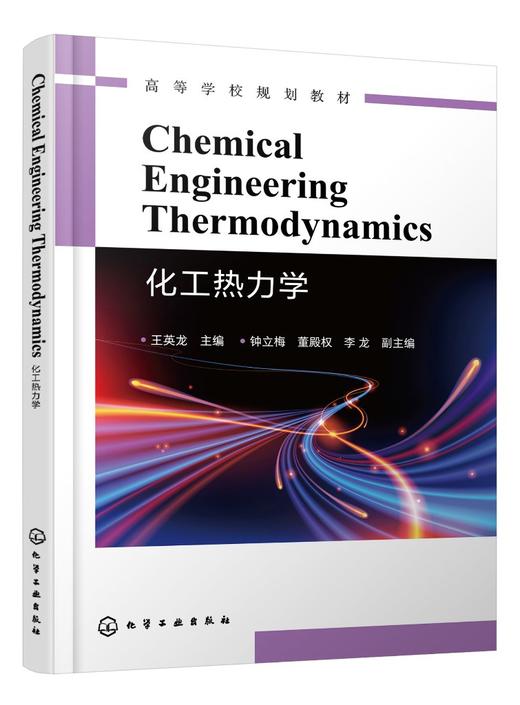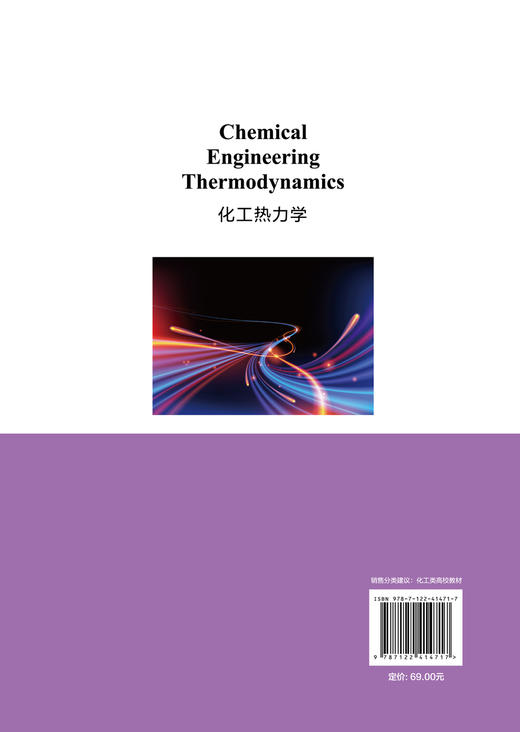商品详情
书名:Chemical Engineering Thermodynamics(化工热力学)
定价:69.0
ISBN:9787122414717
作者:王英龙 主编 钟立梅、董殿权、李龙 副主编
版次:第1版
出版时间:2022-09
内容提要:
《Chemical Engineering Thermodynamics》(化工热力学)共8章,第1章介绍了化工热力学的用途、研究内容、研究特点和基本定律;第2章交代了纯物质的相态变化、纯物质的p-V-T关系、气体的状态方程和对比态原理及其应用;第3章详细讨论了热力学性质间的关系和热力学性质的计算;第4章介绍了剩余性质的定义,阐述了多组分混合物的热力学、混合物的实际热力学行为,不同二元混合物的混合摩尔体积、偏摩尔吉布斯能、偏摩尔体积和焓的实验测定,从实验数据计算无限稀释部分摩尔焓、混合物中组分的吉布斯能和逸度的估计以及偏摩尔吉布斯能和逸度;第5章全面介绍了相平衡判据的数学表达式、化学势和逸度及其在相平衡建模中的应用,讲述了测定液体和固体逸度、分布系数、相对挥发性以及热力学一致性检验。第5章主要涉及了相平衡的相关定律和方程;第6章解释了热机的不可逆性的比率、系统的?变化、?在压缩过程中发生变化、?递减原理与?破坏以及?衡算及?效率;第7章介绍了用简单模型分析制冷循环以及卡诺循环和它在工程中的价值,并对蒸汽和联合动力循环、卡诺蒸汽循环、制冷循环和热泵系统进行了相应的解释;第8章讨论了化学反应平衡基础、化学反应的平衡准则、平衡常数和工艺参数等条件对化学平衡组成的影响。 《Chemical Engineering Thermodynamics》注重理论原理与实际应用的结合,不仅能够为读者提供丰富的热力学基础知识,还能为经验丰富的化工工程师提供所需的专业知识。本书附有大量的例题,并且都系统地给出了解答步骤。读者能够通过本书迅速获取化工热力学的知识内容,适合自学,同时也是学习和掌握专业英语的高效途径。 《Chemical Engineering Thermodynamics》(化工热力学)可作为化工及相关专业的本科生和研究生学习化工热力学的教材,也可供化工专业的过程开发、合成、优化等领域的科研人员参考。
作者简介:
王英龙,青岛科技大学化工学院,教授,王英龙,男。教授,青岛科技大学化工学院。主要教学经历: 化工工艺模拟与计算,2021,本科生,24学时,青岛科技大学 化工原理,2006-2021,本科生,32学时,青岛科技大学 化工热力学,2018-2020,本科生,56学时,青岛科技大学 化工原理实验,2006-2020,本科生,16学时,青岛科技大学 化工过程模拟,2015-2020,研究生,32学时,青岛科技大学 学科前沿讲座,2018-2020,博士生,40学时,青岛科技大学 教学成果: 1. 化工类专业硕士研究生科学认知与工程实践贯通式培养模式,2017年山东省第八届高等教育教学成果奖,一等奖(1/9)。 2. 《含低碳醇二元共沸物共沸特性的QSPR模型及其特殊精馏分离策略》(研究生:梁石生),2018年山东省优秀硕士学位论文。 3. 《混合萃取剂分离THF-乙醇-水三元共沸物系的协同效应及工艺集成与控制》(研究生:赵永滕),2019年山东省优秀硕士学位论文。 4. 多元共沸物节能分离技术及其工业应用(研究生:马康),2018年山东省研究生优秀科技创新成果奖。 5. 乙二醇萃取精馏分离乙醇-四氢呋喃的工程设计与控制(研究生:张青),2015年山东省专业学位研究生优秀实践成果奖。
目录:
Chapter 1 Introduction 1
1.1 The Category of Chemical Engineering Thermodynamics 1
1.2 The Role of Thermodynamics in Chemical Engineering 2
1.3 Fundamental Law of Thermodynamics 3
1.4 Application of Chemical Engineering Thermodynamics 5
1.5 The State and System 7
Chapter 2 The Physical Properties of Pure Substances 10
2.1 Pure Substance 10
2.2 Phases of Pure Substance 10
2.3 Phase-change Processes of Pure Substances 11
2.4 Property Diagrams for Phase-Change Processes 13
2.4.1 The T-V Diagram 14
2.4.2 The p-V Diagram 15
2.4.3 The p-T Diagram 17
2.4.4 The p-V-T Surface 17
2.5 Equation of State 22
2.5.1 The Ideal-Gas Equation of State 22
2.5.2 Nonideality of Gases 23
2.6 Other Equations of State 23
2.6.1 The van der Waals Equation of State 24
2.6.2 Redlich-Kwong (RK) Equation of State 25
2.6.3 The Soave-Redlich-Kwong (SRK) Equation of State 25
2.6.4 Peng-Robinson (PR) Equation of State 26
2.6.5 Virial Equation of State 26
2.6.6 Multiparameter Equation of State 27
2.7 Principle of Corresponding States and Generalized Association 33
2.7.1 Principle of Corresponding States 34
2.7.2 Principle of Corresponding States with Two Parameters 34
2.7.3 Principle of Corresponding States with Three Parameters 35
2.7.4 Generalized Compressibility Factor Graph Method 35
2.7.5 Generalized Virial Coefficient Method 36
2.8 Application of Aspen Plus in Calculation of Thermodynamic Equation of State 39
EXERCISES 43
REFERENCES 44
Chapter 3 Thermodynamic Properties of Pure Fluids 45
3.1 Mathematical Relationship between Functions 45
3.1.1 Partial Differentials 45
3.1.2 Partial Differential Relations 47
3.1.3 Fundamental Thermodynamic Relation 48
3.2 The Maxwell Relations 49
3.3 The Clapeyron Equation 51
3.4 General Relations for dU, dH, dA, and dG 52
3.5 Joule-Thomson Coefficient 58
3.6 The ?H, ?U, and ?S of Real Gas 60
3.7 Application of Aspen in Thermodynamic Properties 62
CONCLUSION 64
EXERCISES 66
REFERENCES 68
Chapter 4 The Thermodynamics of Multicomponent Mixtures 69
4.1 Excess Property 70
4.2 Properties Change on Mixing 71
4.3 Partial Molar Gibbs Free Energy 78
4.4 Gibbs-Duhem Equation 79
4.5 The Experimental Measurement of Partial Molar Volume and Enthalpy 82
4.6 Gibbs Free Energy and Fugacity of a Component in a Mixture 89
4.6.1 Ideal Gas Mixture 89
4.6.2 Ideal Mixture and Excess Mixture Properties 91
4.6.3 Partial Molar Gibbs Free Energy and Fugacity 95
4.7 Application of Aspen Plus to Thermodynamic Properties of multicomponent Mixtures 100
CONCLUSION 103
EXERCISES 103
REFERENCES 105
Chapter 5 Phase Equilibrium 106
5.1 Phase Equilibrium for a Single-Component System 106
5.1.1 Mathematical Models of Phase Equilibrium 106
5.1.2 Fugacity and Its Use in Modeling Phase Equilibrium 117
5.2 Vapor-Liquid Equilibrium 121
5.2.1 Motivational Example 121
5.2.2 Raoult’s Law and the Presentation of Data 123
5.2.3 Mixture Critical Points 131
5.2.4 Lever Rule and the Flash Problem 132
5.3 Theory and Model of Vapor Liquid Equilibrium of Mixtures: Modified Raoult’s law Method 134
5.3.1 Examples of Incentives 134
5.3.2 Phase Equilibrium of Mixture 135
5.3.3 Fugacity of Mixture 138
5.3.4 Gamma-Phi Modeling 142
5.3.5 Raoult’s law Revisited 143
5.3.6 Henry’s law 144
5.4 Wilson and Van Laar Equation 155
5.4.1 Wilson Equation 155
5.4.2 Relationship between Activity Coefficient and Temperature and Pressure 157
5.4.3 Van Laar Equation and Regular Solution Theory 160
5.4.4 Van Der Waals One-Fluid Mixing Rules 161
5.5 Supplementary Simulation Examples 166
5.5.1 Vapor-Liquid Equilibrium Calculations Using Activity Coefficient Models 166
5.5.2 Vapor-Liquid Equilibrium Calculations Using an Equation of State 179
5.5.3 Prediction of Liquid-Liquid and Vapor-Liquid-Liquid Equilibrium 192
EXERCISES 196
REFERENCES 198
Chapter 6 Energy Analysis of Chemical Process 200
6.1 The Definition of Entropy Exergy 200
6.2 Exergy (Work Potential) Associated with Kinetic and Potential Energy 201
6.3 Reversible Work and Irreversibility 203
6.4 Second-law Efficiency 204
6.5 Exergy Change of a System 206
6.5.1 Exergy of a Fixed Mass: Nonflow (or Closed System) Exergy 206
6.5.2 Exergy of a Flow Stream: Flow (or Stream) Exergy 208
6.6 Exergy Transfer by heat, work, and mass 212
6.6.1 Exergy Transfer by Heat, Q 212
6.6.2 Exergy Transfer from Work, Xwork 213
6.6.3 Exergy Transfer by Mass, m 214
6.7 The Decrease of Exergy Principle and Exergy Destruction 214
6.8 Exergy Balance: Closed Systems 219
6.9 Exergy Balance: Control Volumes 227
6.9.1 Exergy Balance for Steady-Flow Systems 228
6.9.2 Second-Law Efficiency of Steady-Flow Devices 230
6.10 Chemical Process Energy Analysis and Aspen Plus 233
EXERCISES 233
REFERENCES 235
Chapter 7 Thermodynamic Processes and Cycles 237
7.1 Chemical Process Design 237
7.2 Real Heat Engines 239
7.2.1 Comparing the Carnot Cycle with the Rankine Cycle 240
7.2.2 Design Variations in the Rankine Heat Engine 241
7.3 The Vapor-Compression Cycle 245
7.4 Power Cycle and Refrigeration Cycle 246
7.4.1 Thermodynamic Cycles 246
7.4.2 Property Diagrams 248
7.4.3 The Carnot Cycle and Its Value in Engineering 248
7.4.4 Air-standard Assumptions 250
7.4.5 Rankine Cycle: The Ideal Cycle for Vapor Power Cycles 251
7.4.6 Energy Analysis of the Ideal Rankine Cycle 252
7.4.7 The Ideal Re-heat Rankine Cycle 254
7.4.8 The Ideal Regenerative Rankine Cycle 255
7.5 Second-Law Analysis of Vapor Power Cycles 255
7.5.1 Combined Gas-Vapor Power Cycles 257
7.5.2 Refrigeration Cycles 258
7.5.3 Refrigerators and Heat Pumps 260
7.5.4 The Reversed Carnot Cycle 261
7.6 Application of Thermodynamic Processes and Cycles in Aspen Plus 262
EXERCISES 267
REFERENCES 270
Chapter 8 Chemical Reaction Equilibrium 271
8.1 Motivational Example: Propylene from Propane 272
8.2 Chemical Reaction Stoichiometry 278
8.2.1 Extent of Reaction and Time-Independent Mole Balances 279
8.2.2 Extent of Reaction and Time-Dependent Material Balances 281
8.3 The Equilibrium Criterion Applied to a Chemical Reaction 282
8.3.1 The Equilibrium Constant 282
8.3.2 Accounting for the Effects of Pressure 285
8.3.3 Accounting for Changes in Temperature 286
8.3.4 Reference States and Nomenclature 292
8.4 Multiple Reaction Equilibrium 293
8.5 Summary 297
8.6 Chemical Reaction Equilibrium Simulation 298
EXERCISES 301
REFERENCES 303
定价:69.0
ISBN:9787122414717
作者:王英龙 主编 钟立梅、董殿权、李龙 副主编
版次:第1版
出版时间:2022-09
内容提要:
《Chemical Engineering Thermodynamics》(化工热力学)共8章,第1章介绍了化工热力学的用途、研究内容、研究特点和基本定律;第2章交代了纯物质的相态变化、纯物质的p-V-T关系、气体的状态方程和对比态原理及其应用;第3章详细讨论了热力学性质间的关系和热力学性质的计算;第4章介绍了剩余性质的定义,阐述了多组分混合物的热力学、混合物的实际热力学行为,不同二元混合物的混合摩尔体积、偏摩尔吉布斯能、偏摩尔体积和焓的实验测定,从实验数据计算无限稀释部分摩尔焓、混合物中组分的吉布斯能和逸度的估计以及偏摩尔吉布斯能和逸度;第5章全面介绍了相平衡判据的数学表达式、化学势和逸度及其在相平衡建模中的应用,讲述了测定液体和固体逸度、分布系数、相对挥发性以及热力学一致性检验。第5章主要涉及了相平衡的相关定律和方程;第6章解释了热机的不可逆性的比率、系统的?变化、?在压缩过程中发生变化、?递减原理与?破坏以及?衡算及?效率;第7章介绍了用简单模型分析制冷循环以及卡诺循环和它在工程中的价值,并对蒸汽和联合动力循环、卡诺蒸汽循环、制冷循环和热泵系统进行了相应的解释;第8章讨论了化学反应平衡基础、化学反应的平衡准则、平衡常数和工艺参数等条件对化学平衡组成的影响。 《Chemical Engineering Thermodynamics》注重理论原理与实际应用的结合,不仅能够为读者提供丰富的热力学基础知识,还能为经验丰富的化工工程师提供所需的专业知识。本书附有大量的例题,并且都系统地给出了解答步骤。读者能够通过本书迅速获取化工热力学的知识内容,适合自学,同时也是学习和掌握专业英语的高效途径。 《Chemical Engineering Thermodynamics》(化工热力学)可作为化工及相关专业的本科生和研究生学习化工热力学的教材,也可供化工专业的过程开发、合成、优化等领域的科研人员参考。
作者简介:
王英龙,青岛科技大学化工学院,教授,王英龙,男。教授,青岛科技大学化工学院。主要教学经历: 化工工艺模拟与计算,2021,本科生,24学时,青岛科技大学 化工原理,2006-2021,本科生,32学时,青岛科技大学 化工热力学,2018-2020,本科生,56学时,青岛科技大学 化工原理实验,2006-2020,本科生,16学时,青岛科技大学 化工过程模拟,2015-2020,研究生,32学时,青岛科技大学 学科前沿讲座,2018-2020,博士生,40学时,青岛科技大学 教学成果: 1. 化工类专业硕士研究生科学认知与工程实践贯通式培养模式,2017年山东省第八届高等教育教学成果奖,一等奖(1/9)。 2. 《含低碳醇二元共沸物共沸特性的QSPR模型及其特殊精馏分离策略》(研究生:梁石生),2018年山东省优秀硕士学位论文。 3. 《混合萃取剂分离THF-乙醇-水三元共沸物系的协同效应及工艺集成与控制》(研究生:赵永滕),2019年山东省优秀硕士学位论文。 4. 多元共沸物节能分离技术及其工业应用(研究生:马康),2018年山东省研究生优秀科技创新成果奖。 5. 乙二醇萃取精馏分离乙醇-四氢呋喃的工程设计与控制(研究生:张青),2015年山东省专业学位研究生优秀实践成果奖。
目录:
Chapter 1 Introduction 1
1.1 The Category of Chemical Engineering Thermodynamics 1
1.2 The Role of Thermodynamics in Chemical Engineering 2
1.3 Fundamental Law of Thermodynamics 3
1.4 Application of Chemical Engineering Thermodynamics 5
1.5 The State and System 7
Chapter 2 The Physical Properties of Pure Substances 10
2.1 Pure Substance 10
2.2 Phases of Pure Substance 10
2.3 Phase-change Processes of Pure Substances 11
2.4 Property Diagrams for Phase-Change Processes 13
2.4.1 The T-V Diagram 14
2.4.2 The p-V Diagram 15
2.4.3 The p-T Diagram 17
2.4.4 The p-V-T Surface 17
2.5 Equation of State 22
2.5.1 The Ideal-Gas Equation of State 22
2.5.2 Nonideality of Gases 23
2.6 Other Equations of State 23
2.6.1 The van der Waals Equation of State 24
2.6.2 Redlich-Kwong (RK) Equation of State 25
2.6.3 The Soave-Redlich-Kwong (SRK) Equation of State 25
2.6.4 Peng-Robinson (PR) Equation of State 26
2.6.5 Virial Equation of State 26
2.6.6 Multiparameter Equation of State 27
2.7 Principle of Corresponding States and Generalized Association 33
2.7.1 Principle of Corresponding States 34
2.7.2 Principle of Corresponding States with Two Parameters 34
2.7.3 Principle of Corresponding States with Three Parameters 35
2.7.4 Generalized Compressibility Factor Graph Method 35
2.7.5 Generalized Virial Coefficient Method 36
2.8 Application of Aspen Plus in Calculation of Thermodynamic Equation of State 39
EXERCISES 43
REFERENCES 44
Chapter 3 Thermodynamic Properties of Pure Fluids 45
3.1 Mathematical Relationship between Functions 45
3.1.1 Partial Differentials 45
3.1.2 Partial Differential Relations 47
3.1.3 Fundamental Thermodynamic Relation 48
3.2 The Maxwell Relations 49
3.3 The Clapeyron Equation 51
3.4 General Relations for dU, dH, dA, and dG 52
3.5 Joule-Thomson Coefficient 58
3.6 The ?H, ?U, and ?S of Real Gas 60
3.7 Application of Aspen in Thermodynamic Properties 62
CONCLUSION 64
EXERCISES 66
REFERENCES 68
Chapter 4 The Thermodynamics of Multicomponent Mixtures 69
4.1 Excess Property 70
4.2 Properties Change on Mixing 71
4.3 Partial Molar Gibbs Free Energy 78
4.4 Gibbs-Duhem Equation 79
4.5 The Experimental Measurement of Partial Molar Volume and Enthalpy 82
4.6 Gibbs Free Energy and Fugacity of a Component in a Mixture 89
4.6.1 Ideal Gas Mixture 89
4.6.2 Ideal Mixture and Excess Mixture Properties 91
4.6.3 Partial Molar Gibbs Free Energy and Fugacity 95
4.7 Application of Aspen Plus to Thermodynamic Properties of multicomponent Mixtures 100
CONCLUSION 103
EXERCISES 103
REFERENCES 105
Chapter 5 Phase Equilibrium 106
5.1 Phase Equilibrium for a Single-Component System 106
5.1.1 Mathematical Models of Phase Equilibrium 106
5.1.2 Fugacity and Its Use in Modeling Phase Equilibrium 117
5.2 Vapor-Liquid Equilibrium 121
5.2.1 Motivational Example 121
5.2.2 Raoult’s Law and the Presentation of Data 123
5.2.3 Mixture Critical Points 131
5.2.4 Lever Rule and the Flash Problem 132
5.3 Theory and Model of Vapor Liquid Equilibrium of Mixtures: Modified Raoult’s law Method 134
5.3.1 Examples of Incentives 134
5.3.2 Phase Equilibrium of Mixture 135
5.3.3 Fugacity of Mixture 138
5.3.4 Gamma-Phi Modeling 142
5.3.5 Raoult’s law Revisited 143
5.3.6 Henry’s law 144
5.4 Wilson and Van Laar Equation 155
5.4.1 Wilson Equation 155
5.4.2 Relationship between Activity Coefficient and Temperature and Pressure 157
5.4.3 Van Laar Equation and Regular Solution Theory 160
5.4.4 Van Der Waals One-Fluid Mixing Rules 161
5.5 Supplementary Simulation Examples 166
5.5.1 Vapor-Liquid Equilibrium Calculations Using Activity Coefficient Models 166
5.5.2 Vapor-Liquid Equilibrium Calculations Using an Equation of State 179
5.5.3 Prediction of Liquid-Liquid and Vapor-Liquid-Liquid Equilibrium 192
EXERCISES 196
REFERENCES 198
Chapter 6 Energy Analysis of Chemical Process 200
6.1 The Definition of Entropy Exergy 200
6.2 Exergy (Work Potential) Associated with Kinetic and Potential Energy 201
6.3 Reversible Work and Irreversibility 203
6.4 Second-law Efficiency 204
6.5 Exergy Change of a System 206
6.5.1 Exergy of a Fixed Mass: Nonflow (or Closed System) Exergy 206
6.5.2 Exergy of a Flow Stream: Flow (or Stream) Exergy 208
6.6 Exergy Transfer by heat, work, and mass 212
6.6.1 Exergy Transfer by Heat, Q 212
6.6.2 Exergy Transfer from Work, Xwork 213
6.6.3 Exergy Transfer by Mass, m 214
6.7 The Decrease of Exergy Principle and Exergy Destruction 214
6.8 Exergy Balance: Closed Systems 219
6.9 Exergy Balance: Control Volumes 227
6.9.1 Exergy Balance for Steady-Flow Systems 228
6.9.2 Second-Law Efficiency of Steady-Flow Devices 230
6.10 Chemical Process Energy Analysis and Aspen Plus 233
EXERCISES 233
REFERENCES 235
Chapter 7 Thermodynamic Processes and Cycles 237
7.1 Chemical Process Design 237
7.2 Real Heat Engines 239
7.2.1 Comparing the Carnot Cycle with the Rankine Cycle 240
7.2.2 Design Variations in the Rankine Heat Engine 241
7.3 The Vapor-Compression Cycle 245
7.4 Power Cycle and Refrigeration Cycle 246
7.4.1 Thermodynamic Cycles 246
7.4.2 Property Diagrams 248
7.4.3 The Carnot Cycle and Its Value in Engineering 248
7.4.4 Air-standard Assumptions 250
7.4.5 Rankine Cycle: The Ideal Cycle for Vapor Power Cycles 251
7.4.6 Energy Analysis of the Ideal Rankine Cycle 252
7.4.7 The Ideal Re-heat Rankine Cycle 254
7.4.8 The Ideal Regenerative Rankine Cycle 255
7.5 Second-Law Analysis of Vapor Power Cycles 255
7.5.1 Combined Gas-Vapor Power Cycles 257
7.5.2 Refrigeration Cycles 258
7.5.3 Refrigerators and Heat Pumps 260
7.5.4 The Reversed Carnot Cycle 261
7.6 Application of Thermodynamic Processes and Cycles in Aspen Plus 262
EXERCISES 267
REFERENCES 270
Chapter 8 Chemical Reaction Equilibrium 271
8.1 Motivational Example: Propylene from Propane 272
8.2 Chemical Reaction Stoichiometry 278
8.2.1 Extent of Reaction and Time-Independent Mole Balances 279
8.2.2 Extent of Reaction and Time-Dependent Material Balances 281
8.3 The Equilibrium Criterion Applied to a Chemical Reaction 282
8.3.1 The Equilibrium Constant 282
8.3.2 Accounting for the Effects of Pressure 285
8.3.3 Accounting for Changes in Temperature 286
8.3.4 Reference States and Nomenclature 292
8.4 Multiple Reaction Equilibrium 293
8.5 Summary 297
8.6 Chemical Reaction Equilibrium Simulation 298
EXERCISES 301
REFERENCES 303
- 化学工业出版社官方旗舰店 (微信公众号认证)
- 扫描二维码,访问我们的微信店铺
- 随时随地的购物、客服咨询、查询订单和物流...











